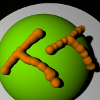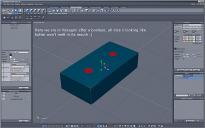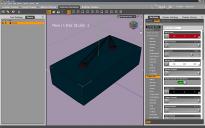Help Filling In The Dots ( A discussion about booleans, domains and sending to Daz Studio)
 TapiocaTundra
Posts: 268
TapiocaTundra
Posts: 268
Hi Hexagoners
I have been experimenting with Hex.for a few months now, I really am trying hard with it, we all know it is a frustrating piece of kit and it crashes at the drop of a hat but I sort of like it.
I am modelling a fret board for a ukulele, but in this simple test case lets call the object a domino.
All I want to do is have the dots a different material to the domino without the mesh getting chopped up and messed up when sent to Daz Studio.
I understand shading domains, and have tried all the boolean operations and various methods of tessellation, "tessellation I feel is the clue to my problem."
This is most probably a general modelling technique although since Hex. has it's own way of breaking stuff I thought to ask for assistance here.
Any help will be very much welcome.
Thanks






Comments
I generally avoid boolean operations like the plague.. they are notorious for giving problems, especially when trying to export/import. They tempt you with their simplicity like a heart shaped box of chocolates with a bomb inside ;p
I agree Gedd but how else do I get the job done?
This should be such a simple thing to do.
Booleans are really just a short-cut to what you could do the long way around - so you make your choice - take the short-cut and spend extra time fixing the mess, or take longer to model it right first time. Mostly they are unnecessary, but can be managed if you understand the basics.
Here's one of many ways to make that domino - you are right, judicious tessellation is the clue:-)
booleans are a spawn of the devil....
you could also just UV map your object, and have the map 'paint' in the fret dots...
or do what i do.. .play the fiddle and you have no frets to worry about...
:)
Well thank you Roygee for taking time to set up a demo. I think I get the no boolean box model technique, although surprised at the use of smoothing, maybe in the case of my fretboard, maybe a little over the top although the domino might like it :) still looking for alternatives, or preferably the best procedure though, so more comments are most welcome.
Thanks again Roygee special to take time like that.
I don't understand why you need them to be 2 different materials.
Just map the domino and apply a texture map with 2 dots on it.
Are the dots supposed to move around or change size or shape?
Not the same at all afreaginname in fact I do not want to use maps only materials. In Daz Studio and Poser.
hiker_1, you have to be able to play the fiddle to use Hexagon!
Then your ONLY option is Roygee's suggestion. The faces of your dots will be one domain, and the faces on the domino will all be a different domain.
As long as you keep in mind that without UV mapping, these domains can ONLY be colored and not textured, you'll be fine.
tapioca -- well... i use hexagon and i play the fiddle... although there is some discussion about whether i play the fiddle or play *with* a fiddle... maybe if i practice my fiddle more i'll get better at hexagon too!
In fact I made the ukulele some weeks ago using Sketchup but as I wanted try and make a nice version for Poser or Daz Studio have had to practically re-build the darn thing, here is a cheap Bryce Pro render, just with materials, Bryce can be very forgiving on .obj imports.
If my old Dad had got me a Rickenbacker 330 instead of a uke I might not have been plodding around with 3D stuff and been very wealthy by now :P
I'm not sure we're speaking the same language here.
Earlier when I suggested you use a texture map to place dots on the domino, you said "I do not want to use maps only materials".
And here you post a picture of a render and say "here is a cheap Bryce Pro render, just with materials".
Here's my confusion: You are CLEARLY using texture maps on the body. That's the only way you can have that wood texture on there.
When you create a mesh, all the faces are automatically assigned to a default material called "def_surf_mat" which isn't visible in hexagon. For user convenience, these faces are called "unassigned faces" in the materials sidebar.
When you assign some of the faces in the model to a shading domain, it becomes a "material".
This material can then be colored to the user's choice, but it can't be textured with a map.
UV mapping a model tells hexagon where/how to place sections of texture maps, so that once UV mapped, a material can be either colored or have a texture map applied or both.
At the very least, the body of your uke has been UV mapped and a "wooden" texture map image has been assigned to the body's material.
So I'm very confused by what you mean by "I do not want to use maps only materials".
Not necessarily - it could be done with a procedural texture. I usually use procedurals and only UV map for 3d painting or painting in a 2d editor.
Just to illustrate the point on Boolean - I can't imagine doing the attached any other way than with Boolean. It could be done, but I'd hate to be the one to do it.
Now this renders perfectly in Hex, Carrara, Poser, Bryce and Blender, but Daz Studio makes a total mess of it. Could spend a couple of days fixing it for Studio, but why bother when there are decent render engines out there.
BTW, the domino did not actually need that level of smoothing - I wanted to get the dots nice and round and recessed. I fully agree that the best method to do what you are wanting with a low poly count is to UV map and paint the dots.
Hi afreaginname thanks
I get what you are saying, I understand how to map with textures, to a point.
Sorry to destroy your theory that my render was made using texture maps though, I have to tell you that they are all procedural materials used in the image,(all maths and no maps) clever isn't it.
I do not think you have used Bryce before, might pay you to understand a little more about other software before making sweeping statements about how things work :)
I got the wood material from http://www.tonylynchdesigns.com/bryce_materials.htm
If you feel you need to check it out, there are lots and I think rather good.
Thanks for the back up Roygee, boolean and domains is really the way I am thinking though, you see some fret boards are overly ornate with mother of pearl inlay and so forth, it might be nice to get some transparency, reflectance and volume into the materials, also to be able to swap the decoration of the inlay about within Poser or Daz. I think I may have made a step further.
Very nice work there Tapioca. :)
The thing about booleans is that they will always leave triagular faces or co-planar faces. Hexagon can get rid of some of those under Utilities>Merge Triangular Facets, but not all of them will be merged. Lightwave has a very nice merge utility.
One can go ahead and use booleans. What I did in the image below is give the cube some divsions when I made, then subdived the sphere before the boolean operation. One will end up with triangular faces, but the will be uniform for the most part.
There are still major problems with it though if one brings it to DAZ Studio Render with artifacts.
Edit: Added Carrara Render
Yep - when you understand the basics and are prepared to work within the limitations, they are fine - but best used only as a last resort.
Just for the heck of it, here's another domino extruded from a hemisphere - many other ways of doing it.
Fretwork and inlays really brings out the strength of Hex in modelling with splines - they are so versatile.
I think this was an honest mistake. While most if not all render engines provide for the use of procedural textures, I don't think there's one out there that uses them even close to what they are used in Bryce. I did use Bryce a bit in the past, and used, even created my own procedurals. But, it's been so long I forgot how much they are used also.
This does point out why it is good to use different software packages, they give us a different way of looking at doing something and expand our toolbox of tricks no matter what package we happen to be using at the moment. Anyone using any application who hears someone else say 'that's not a real xxx' can take heart in this. Each teaches us things, and anyone who doesn't recognize this is cutting themselves off from valuable learning opportunities.
I think this is an excellent example actually. There are tricks to getting this without booleans but with all the curves it would be challenging and probably higher poly then one would wish. Sometimes booleans are good for quick and dirty stuff or things like this that would be not worth the effort to do another way. There are tricks to using booleans without it blowing up on you. Some software creates better/more compatable boolean geometry. Maya for instance is supposed to be better at this than many and some packages really concentrate on good booleans (Rhino maybe, don't remember.) Also, what you are trying to do plays a big part. Booleans are better for solid objects then something that one is going to rig or apply SubD etc.. on. Some people love booleans and will use them, only switching to something more 'manual' if the boolean blows up and this is a valid approach.
The main thing here is to be aware that booleans are their own beast and have idionsyncracies that one either takes into account or avoids by avoiding using them.
I believe this is one of the problems with DAZ dealing with booleans. Many software packages have problems with triangles and they need to be converted to quads to work properly.
No need to get smartassed. You were trying to do something and I was trying to help you do it.
3D modelling is ALL math. Whether you're creating a mesh plane or rendering a complex scene, it's 100% math.
Whether you like it or not, the "wood material" MAT file you got from tony lynch was a texture map image inside a proprietary file which may or may not be based on the matlab MAT file format, though it wouldn't surprise me if it was.
"Procedural" processes may look like magic, but down in the bowels of bryce the application of a texture map to a mesh is no different than any other program, only the LANGUAGE is different, which were the first words out of my keyboard in my previous post.
This is, after all, a hexagon discussion group. I understand hexagon very well, and I also understand meshes, materials and mapping down at the nuts and bolts level better than any 10 people you'll ever come across.
So excuse me for trying to translate your brycean into hexagonese so I could understand what was in your mind.
Hi Gedd :-)
Daz Studio has no problems with tri's, as such - there's something else which causes it to mess up Hex Booleans - in other discussions it appears to be some sort of automatic smoothing operation it performs on importing .obj. I don't know much about Studio - only have it because it's necessary to have Genesis work in the Carrara Beta.
Obviously some poly modeller software is better at some things than others - the orange .obj in my pic was made in Blender, as is. The green one in Hex, after triangulating N-gons. See the difference in how the tri's are laid out. Strangely enough, the Blender one couldn't even import into Studio - gave an error report. After exporting from Hex to .obj, it opened and rendered perfectly in Studio.
As expected, the Hex one was a mess in Studio.
So it appears that if you want a Boolean to render in Studio, you need to make it in Blender and export it through Hex - It's a strange,strange world, Master Jack:-)
:-) There you go again sweeping statements around with your big old brush.
This of course may or may not be based on your knowledge of procedural materials I take it.
Lets be friends eh :-)
Hehe, tyvm for that summary clarification. I had seen bits of this in various discussions but don't remember seeing it summarized so well. I'll be clipping that for my notes (evernote to the rescue ;) )
Oh btw, the second one looks like it would definitely UV Map more cleanly. I might try to redo the top though bfr exporting if I were keeping it.
Id did make a good map after some cleaning up - in fact, it would have been quicker just to model it in the first place. The thing is, the algorithms don't have any sense of aesthetics, they just do what they have to.
Now if some clever programmer would teach Booleans to cut new edges in the surrounding geometry and leave the user to deal with the resulting N-gons, instead of just connecting to the nearest corner and leaving us with those long, thin tri's and ugly poles, they would be much more useful.
What surprised me is that Blender, which is far more sophisticated than Hex, only has three Boolean options, where Hex has 12, plus a control for the depth of the cut.
I use Hex intermittently - like for this illus I did for an article on back to school supplies (just showing wire frame here)
I see your domino box-model method, but would that make a hole all the way through a preexisting mesh?
Say I wanted to drill a hole through the notepad in the illustration, but do not want to remake the model?
(I don't do DAZ studio... for the illustrations, I normally render in Carrara)
Thanks
Well one way to do it would to be to bring it into Blender as an obj, create boolean holes, export as obj and bring back into hex for cleanup. Unfortunately I don't have a link to a tutorial that would step you through that process. Blender's interface might be much for most people but it can be helpful to learn enough to use it for simple tasks like this. Sometimes a certain package just does a particular task better than the others.
There are some good tutorials on Hexagon at Geekatplay.com for anyone who hasn't been there but I also got some good tips in Fugazzi's clothing tutorials here in the DAZ store and recommend them for anyone wanting to see some tips on cleaning up meshes in Hexagon as i haven't seen some of his methods shown that clearly anywhere else. (Not that someone else hasn't done so, I just haven't run across it.) As for Blender, if anyone is so inclined, Youtube and Blender.org both have many good tutorials.
I would just do it in 2D graphics myself.
Edit: A quick go at the Hexagon modeled box and spiral with a Carrara render. Needs a few more tweaks to meet standards, but it's a workable solution in my opinion.
I would have done something similar...in the 3D model simply add circular planes (small) right where you want holes to show and wires to poke thru; just above the surface of the notebook cover.
Use a black shader on the circular shapes to make them look like deep holes. If closeup, maybe use a shader that has an arch of dark gray and gradient to black to show greater reality.
But I think the above render with texture map "holes" looks very good.
Fully agree that faking with texture is the most efficient way t go, but yes, if you really wanted to make physical holes, Booleans would do it, but you would need to add a lot of mesh to define the edges of the holes. Starting from scratch, the best bet is to make a grid, delete the polys for the holes and give it thickness.
When I was using Anim8or, which doesn't have Boolean, we discovered a technique which works just as well in Hex and called it "fake Boolean" . You select two opposing facets and bridge them - gives a very clean cut, without any ugly mesh distortion .
BTW are you the illustrator/cartoonist who created the most amazing sculpture of a head in Hex that I have ever seen?
Woops - picture :red:
Yup, those suggestions you gave work as well.
Sometimes I use Adobe Illustrator or Xara Graphic Designer to put in Boolean holes in the artwork. They are preserved when you assign the texture (32 bit png) to the mesh and allow lighting and shadows to act on the mesh normally.
In the image below is a close up of my previous image. I used Xara Graphics Designer to cut boolean holes into the image.